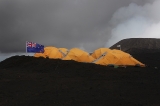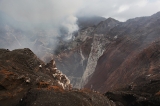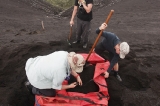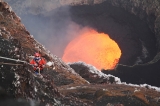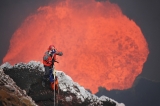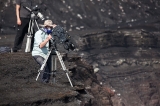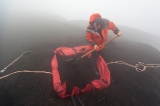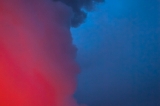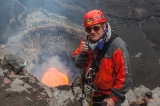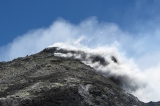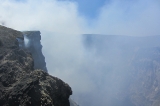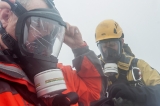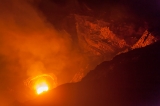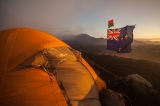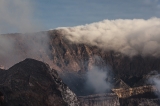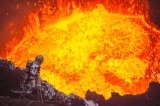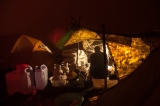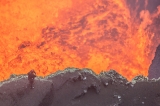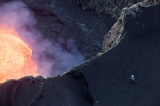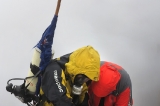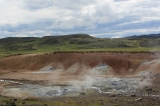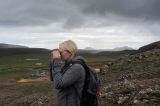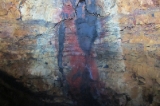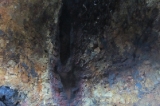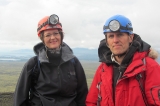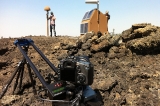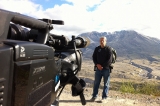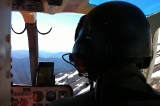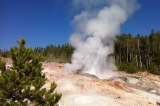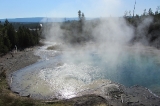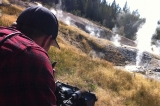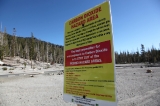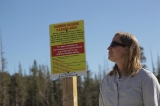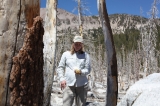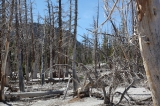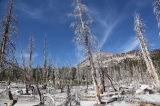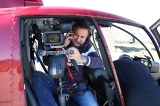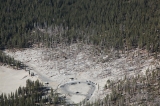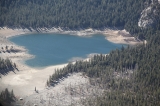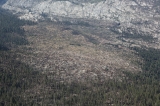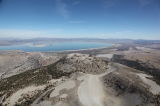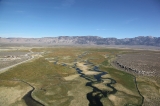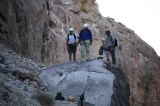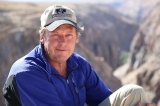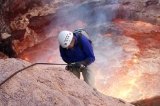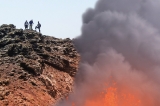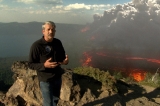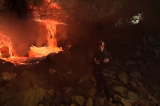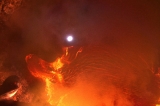[tab:Volcano Time Bomb]
The threat of a cataclysmic volcanic eruption that could wipe out millions of people is very real. Predicting where and when the next volcano might erupt could help avoid a tragedy. But understanding a volatile system that lies many miles underground is extremely difficult. Now an elite group of scientists is going further than ever before as they race to unlock the secrets of volcanoes before the next big one strikes. Volcano Time Bomb combines real scientific missions with cutting edge computer graphics to offer a comprehensive view of Planet Earth’s most powerful and potentially lethal force.
Volcano Time Bomb Teaser
Exploring Magma
Yellowstone Super-Eruptions
[tab:Photos]
[tab:Press]
NHNZ News
 NHNZ and Edge West dig into Volcano science for Discovery Channel’s CURIOSITY series:
NHNZ and Edge West dig into Volcano science for Discovery Channel’s CURIOSITY series:
Wednesday, December 5, 2012
Discovery Channel has commissioned NHNZ to produce a one-hour special on the science of predicting volcanoes for the channel’s high-profile Curiosity series.
Volcano Time Bomb shows the latest work in the world of volcano eruption forecasting and to see how powerful science can be in helping to understand volcanism. No simple science given that each volcano is different, and there are 1500 of them around the world – 169 in the US alone.
With a tight schedule, and a gruelling list of shoots, including many North American sites NHNZ executive producers Craig Meade and Phil Fairclough worked with producer Phil Day from Edge West in Los Angeles to produce the show.
To understand the science, the crew had to follow the scientists and get up close to the action at nine volcanoes around the world – all of them active, and two of them erupting. For Phil Day, the chance to produce this show was a no-brainer.
“As a kid one of my favorite books was Jules Verne’s Journey to the Center of the Earth. Their point of entry was an extinct volcano in Iceland – and I know there actually is an extinct volcano in Iceland that you can now go down inside – and I was absolutely desperate to see it – so for me it was the adventure of a lifetime. But more than that, it’s the power of volcanoes that fascinates me. As explorer Geoff Mackley says in the film ‘It’s kind of hard to describe the amount of power required to boil rock and throw it through the air like water‘. And it truly is.
“I think Volcano Time Bomb brings a really important reality to the audience – monitoring and predicting when the most dangerous volcanoes will next erupt is fast becoming a crucial science for our society’s long-term survival,” says Phil Day.
NHNZ EP and EVP Development, Phil Fairclough saw Volcano Time Bomb grow out of a pitch originally calledThe End of the World: Live.
“Our original idea was to see what events might actually have the power to bring about the end of the world, if it was going to happen on Dec 21 2012, when the Mayan calendar ends. We quickly boiled it down to a discussion of volcanoes, as the most devastating force on Planet Earth…and the least predictable force of nature about which very little is understood, especially in the field of forecasting.
“And surprisingly, in North America, we are all much more at risk of the effects of a volcanic eruption than most of us know. A big eruption of a super volcano has the power to bring the entire US to a standstill and kill millions. We are all sitting on a volcano time bomb.”
Volcano Time Bomb premières on Discovery Channel’s CURIOSITY series on Sunday, December 9 at 9 PM.
CURIOSITY on Discovery Channel brings the ‘I wonder?’ moment to television with a unique array of provocative subjects. Testing theories on a scale never done before, CURIOSITY looks at the science behind the world’s most mysterious places and events.
TV By The Numbers
‘Curiosity’ Attempts to Unlock the Deadly Secrets of Volcanoes
December 4th, 2012
(Los Angeles, Calif.) – Volcanoes are one of the most powerful forces on Earth – capable of causing massive destruction for the millions of people who live in their shadow. These giants loom over Portland, Seattle and Vancouver with the potential to cause complete devastation. Last week, Kilauea Volcano on the Big Island of Hawaii erupted with lava flowing into the nearby ocean. Is enough being done to monitor their potential eruptions? And is it actually possible to crack their code and predict when a deadly eruption might occur?
“Volcano Time Bomb,” airing Sunday, Dec. 9 at 9 PM E/P on Discovery Channel’s CURIOSITY series, will take viewers into the heart of a volcano using CGI technology to uncover how they actually work and why they are so difficult to understand. The episode will also show the latest research in the field of volcano eruption forecasting and the scientists who risk their lives to find answers.
In May 1980, the world watched as Mount St. Helens unleashed its powerful forces and obliterated every living thing in its path. But there is actually another type of volcano, unknown to many, that is thousands of times more powerful than Mount St. Helens. These super volcanoes have the potential to bury most of western North America and dim the sun — plunging the world into a volcanic winter. “Volcano Time Bomb” looks at how experts are monitoring these powerful forces and the Earth’s natural reactions – including ground deformation, gas emissions and earthquakes – to make their predictions about the next big eruption.
“Volcano Time Bomb” is produced by NHNZ for Discovery Channel. CURIOSITY is overseen by Vice President, Development and Production Howard Swartz and Senior Vice President, Development and Production Simon Andreae. To learn more, go to www.discovery.com, on Facebook at Facebook.com/discovery and on Twitter @Discovery. Intel is a presenting sponsor of “Volcano Time Bomb.”
Real Screen
“Volcano Time Bomb” to debut on Discovery
December 5, 2012
Discovery Channel is to air Volcano Time Bomb, a one-hour special about the science of monitoring and predicting volcanic eruptions, on December 9.
Produced by New Zealand-based indie NHNZ, the program will air as part of the U.S. cable network’s ‘Curiosity’ strand.
The special follows scientists as they attempt to gauge potential eruptions and, more broadly, society’s long-term survival. The shoot took executive producers Craig Meade and Phil Fairclough, and Edge West producer Phil Day, to nine active volcanoes around the world, including many in North America.
The idea evolved from an idea based on the Mayan calendar doomsday scenario hype called The End of the World: Live.
“Our original idea was to see what events might actually have the power to bring about the end of the world, if it was going to happen on December 21, 2012 when the Mayan calendar ends,” Fairclough said in a statement. “We quickly boiled it down to a discussion of volcanoes, as the most devastating force on planet Earth and the least predictable force of nature about which very little is understood, especially in the field of forecasting.
“Surprisingly, in North America, we are all much more at risk of the effects of a volcanic eruption than most of us know,” he added. “A big eruption of a super volcano has the power to bring the entire U.S. to a standstill and kill millions.”
Volcano Time Bomb will premiere on Discovery Channel on December 9 at 9 p.m. EST/PST.
Examiner
Discovery Channel will air, Volcano Time Bombs, on their Curiosity series Dec..9
On Sunday at 9 P.M. Discovery Channel will air “Volcano Time Bombs” on their Curiosity series, which will take viewers into the heart of a volcano in an effort to uncover how they actually work. The episode will also focus on the latest research in volcano eruptions and why they are so difficult to understand.
Phil Zimmerman’s media alert stressed how powerful volcanoes are and the massive destruction they cause to millions of people who live within their shadow. It also touched upon the recent eruption of lava from Kilauea on Hawaii’ Big Island, which is still flowing into the nearby ocean; and the eruption of Mount St Helen in Washington State in 1980, when it’s powerful forces obliterated everything in it’s path.
These are the volcanoes we know of, but according to the ‘Media release’ there are super volcanoes, presently unknown, that are a thousand times more powerful and have the potential to bury most of western North America, dim the sun, and plunge the world into a volcanic winter.
Volcano Time Bomb, which airs this Sunday at 9 p.m. was produced by NHNZ for the Discovery Channel. It looks at how the experts are monitoring these powerful forces and Earth’s natural reaction in the hopes of being able to predict the next big eruption. CURIOSITY is overseen by Howard Swartz, Vice-President and Simon Andrea Senior Vice-President, of Development and Production For users of Facebook visit facebook.com/discovery and Twitter followers can access it at twitter.com@discovery.
Discovery Channel is dedicated to creating the highest quality non-fiction content, that not only informs but entertains the consumer about the world and all it’s wonders. It is distributed to millions of U.S. homes and can be seen in over 210 countries. For more information visitwww.discovery.com
Outside Online
The latest episode of the Discovery Channel’s “Curiosity” takes viewers into the heart of a volcano using CGI technology to uncover how they actually work and why they are so difficult to understand.
Carter
‘Curiosity: Volcano Time Bomb’ review: Truth and quiet dangers
Perhaps it is due to more frequent natural disasters, but the potential deadly impact of volcanoes is something that is frequently forgotten about when it comes to the average American. After all, it has been decades since Mt. St. Helens erupted in Washington, and in the span of time most of our attention has been diverted to fending off earthquakes and hurricanes.
 However, some of this thinking may change for those who watch the latest “Curiosity” special “Volcano Time Bomb” on Sunday night, as it provides a series of harrowing reminders that there is still not only serious danger out there within populated regions of the world, but that these eruptions can destroy whole cities without the proper amount of caution exercised.
However, some of this thinking may change for those who watch the latest “Curiosity” special “Volcano Time Bomb” on Sunday night, as it provides a series of harrowing reminders that there is still not only serious danger out there within populated regions of the world, but that these eruptions can destroy whole cities without the proper amount of caution exercised.
Is there any surefire way to prevent an eruption from happening? No, and as the title suggests, what we are generally looking at here is just a waiting game until the next one comes. However, there are ways to minimize the impact of and loss of life, and we see through this just what many brave scientists are doing at the moment to learn how to detect possible eruptions in their early stages, whether it be by surveying the land, reading vibrations underneath the surface, or detecting levels of CO2 in soil that can only be caused by magma. For those familiar with volcanoes already, this special may not teach you too much beyond what is already in your knowledge base, but what it does is present all of its information in a detailed, stunning format that includes both real and simulated footage of eruptions. No network produces a better visual way in which to display the information.
With some of these “Curiosity” specials this year, we have left wondering to ourselves a series of key questions, whether it be how effective the ancient Egyptian mummifcations were as a practice of preservation or whether a human being can really be hypnotized to commit a deadly act. With “Volcano Time Bomb,” you are getting something that is a little more informative and a little less open to debate. It is common knowledge that that eruptions are dangerous; the only thing that is surprising is how they continue to shy away from the forefront of public consciousness.
Yahoo News
Scientists working to predict next supervolcanic eruption
Could a supervolcano someday erupt in the U.S., burying most of North America in ash, dimming the sun and sending the continent into a volcanic winter? That’s the focus of the Discovery Channel’s “Volcano Time Bomb,” part of the network’s Curiosity series.
According to the U.S. Geological Survey, a supervolcano is one that possesses “a volcanic center that has had an eruption of magnitude 8 on the Volcano Explosivity Index (VEI), meaning the measured deposits for that eruption is greater than 1,000 cubic kilometers (240 cubic miles).”
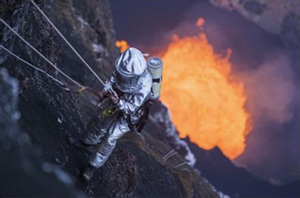
A researcher descends toward the crater of an active volcano. (Discovery Channel)
The show focuses on volcanic giants that loom over Portland, Seattle and Vancouver and comes on the heels of Hawaii’s Kilauea spilling lava into the ocean. Using computer-generated imagery, the show will take viewers inside some of these volcanoes. But the show also focuses on the latest scientific efforts by researchers who are attempting to forecast when and where the next major eruption will take place.
Other supervolcanoes in the U.S. are located in Yellowstone National Park and Long Valley in eastern California. Outside the U.S., supervolcano sites have been identified in Indonesia, Japan, New Zealand and South America. The last known supervolcanic eruption took place approximately 27,000 years ago on New Zealand’s island of Taupo.
“These super volcanoes have the potential to bury most of western North America and dim the sun—plunging the world into a volcanic winter,” reads a release from Discovery sent to Yahoo News.
Watch an exclusive preview of the “Volcano Time Bomb” episode below, which airs on the Discovery Channel on Dec. 9 at 9 p.m. ET:
Awesome DL
In the Volcano Time Bomb, Curiosity will go around the world to find out how scientists are attempting to do something once thought impossible: predict when a deadly volcanic eruption will occur. Millions of people live in the shadow of active volcanoes where the threat of eruption is always looming. Using CGI technology, Curiosity takes viewers into the heart of these epic natural monsters to show how volcanoes actually work and why they are so difficult to understand. The episode goes inside the labs of the world’s leading experts to answer the ultimate question: Is it possible to predict the next volcanic eruption and unlock its deadly secrets?
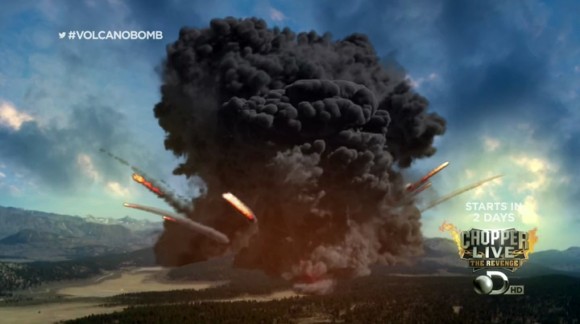

Hollywood Soap Box
Discovery Channel set to air volcano special; expert identifies volatile hotspots
In the wake of Hurricane Sandy, some people might have forgotten the dangers inherent in other natural phenomena. Volcanoes, often relegated to fantasy books and memories of exotic locales, are important geological case studies, and Discovery Channel is turning its ever inspecting eye on the fiery mountains.

Curiosity, the documentary series that airs Sundays at 9 p.m., will broadcast “Volcano Time Bomb” on Dec. 9. Experts on the program talk about the most volatile volcanoes in the world and how communities may face unprecedented destruction.
Recently, Hollywood Soapbox exchanged emails with Dr. Andrew McGonigle, reader in volcano remote sensing at the University of Sheffield. McGonigle is interviewed on the one-hour special. Answers have been slightly edited.
In your opinion, is it possible to predict volcanic activity and eruptions? Could there be an effective early warning system one day?
The capacity to understand volcanic activity is expanding enormously and with every new eruption we learn something new about how the Earth works, with beneficial impacts upon our ability to predict eruptions. There have been some great examples of success in this regard: for instance a few days before the largest recent eruption, Mt. Pinatubo in 1991, an evacuation order was given, which saved many thousands of lives.
Likewise, technological advancements are enabling us to resolve what is going on beneath the ground far more clearly than before, showing great promise for effective early warning systems. A real key is the ability to piece together the different pieces of the puzzle, for instance, in measuring the earthquakes from volcanoes, the gases which are released from summit craters and the deformation of the ground in response to magma movements. We are getting much better now at integrating these different sources of information, to provide a far more robust assessment of the volcano’s status than possible from the individual data sources in isolation.
Is enough of the world tuned into the dangers caused by volcanoes?
This is a great question. We tend to be so preoccupied by our immediate concerns, that further away or less frequent phenomena drift off our radar screens. In many parts of the world, for instance Indonesia, or of course Hawaii and the Cascades in the USA, volcanic eruptions are frequent, or at least not too infrequent, events so people are mindful of them and of the various perils and inconveniences that they cause.
However, for those of us who live in more geologically tranquil locations, for instance in the UK, volcanoes seem a world away. Hence, the Icelandic eruption of 2010, with all the flight chaos it caused, was a rude awakening indeed to the fact that we live on a geologically active world! This event also revealed, to a certain degree, a lack of preparedness amongst civil authorities to cope with what, volcanically, was a relatively benign eruption. Hence we do need to be more aware of these kinds of events, and the far off effects they can have, and to plan in advance appropriate measures, for what we will do when they occur.
From your experience, what are some of the most volatile volcanoes in the world, and why?
My own work has taken me to some fairly volatile spots. Stromboli in Italy is a spectacular example of a volcano venting its fury, in explosions every 10 or so minutes. This is dubbed the lighthouse of the Mediterranean for these metronomic outbursts which have generated a natural firework show for at least the last few thousand years. I still find it truly awesome to think of the Greek and Roman mariners who witnessed the same sight in their sea passages during bygone millennia.
Vesuvius is currently inactive, but bursts into life sporadically and has every potential to repeat the level of violence associated with the AD 79 eruption that led to the fall of Pompeii. This is particularly troubling given the heavily congested population within the surrounding bay of Naples region. Finally, other volcanic targets show signs of resumed life: Krakatoa in Indonesia, which erupted catastrophically in 1883, has recently resumed low level activity; and Santorini in Greece has experienced earthquakes indicating restless subsurface magmas. During the 16th century BC this latter island volcano literally blew itself apart, collapsing into the sea, possibly leading to the origin of the Atlantis myth.
How did you get involved in this field? Is it dangerous, especially when working on site?
I started out doing a doctorate in lab physics where I designed sensors for monitoring pollutants in the atmosphere. I then took a research job using similar techniques but for measuring gas releases from volcanoes in order to understand the underground workings of volcanic systems. Somewhere along the line I became a volcanologist and started being able to tell people about what I did for a living at parties without them falling asleep!
The transition from working in a controlled laboratory environment to doing research on volcanoes, a tiny speck, clambering over these geological powerhouses, was also enormous, and never ceases to be exhilarating. This of course brings with it an element of danger, and one must always have a profound sense of respect for the force of nature. In this sense we are always careful to take every precaution, and certainly wouldn’t access craters during explosive episodes. Two days before the filming of the Discovery documentary we were showered in rock fragments from an explosion whilst working on the summit of Mt. Etna; that was our cue that our work was finished for that day.
Were you impressed by Discovery’s special? Why are TV programs like this important for understanding volcanoes?
I really enjoyed the documentary, and it was great to see a number of my colleagues from other countries also featuring on the program. I think the use of computer animations was brilliant in conveying eruptive processes, and it was great to see my colleague Ken Sims “climbing” down into the innards of a volcano with a little help from the special effects team. This was so realistic in fact, that I had to spend quite a long time afterwards explaining to my 5-year-old son that it wasn’t “real,” and that I couldn’t take him down to see a magma chamber next time I am on a volcano!
Scientific documentaries can now be as visually appealing as feature films in terms of their animation and some of this documentary’s computer generated pyrotechnics brought to mind volcanic scenes from the Lord of the Rings and Star Wars films.
In terms of the role that TV programs play in disseminating scientific knowledge, this is really important, and has a massive effect on public understanding (or misunderstanding!). It is really challenging to deliver factual programming which really captures the attention of viewers, while remaining true to the nuances of the science in question. However, in the case of this documentary, I think a good balance was struck: after all, it is hard to overplay what volcanoes are capable of doing!
[tab:To Buy]
Purchase Volcan Time Bomb
[tab:Media Release] 5 December 2012
NHNZ and Edge West dig into Volcano science for Discovery Channel’s CURIOSITY series
Discovery Channel has commissioned NHNZ to produce a one-hour special on the science of predicting volcanoes for the channel’s high-profile Curiosity series.
Volcano Time Bomb aims to show the latest work in the world of volcano eruption forecasting and to see how powerful science can be in helping to understand volcanism. No simple science given that each volcano is different, and there are 1500 of them around the world – 169 in the US alone.
With a tight schedule, and a gruelling list of shoots, including many North American sites NHNZ executive producers Craig Meade and Phil Fairclough worked with producer Phil Day from Edge West in Los Angeles to produce the show.
To understand the science, the crew had to follow the scientists and get up close to the action at nine volcanoes around the world – all of them active, and two of them erupting. For Phil Day, the chance to produce this show was a no brainer.
“As a kid one of my favorite books was Jules Verne’s Journey to the Center of the Earth. Their point of entry was an extinct volcano in Iceland – and I know there actually is an extinct volcano in Iceland that you can now go down inside – and I was absolutely desperate to see it – so for me it was the adventure of a lifetime. But more than that, it’s the power of volcanoes that fascinates me. As explorer Geoff Mackley says in the film ‘ It’s kind of hard to describe the amount of power required to boil rock and throw it through the air like water ‘. And it truly is.
“I think Volcano Time Bomb brings a really important reality to the audience – monitoring and predicting when the most dangerous volcanoes will next erupt is fast becoming a crucial science for our society’s long term survival,” says Phil Day.
NHNZ EP and EVP Development, Phil Fairclough saw Volcano Time Bomb grow out of a pitch originally called The End of the World: Live.
“Our original idea was to see what events might actually have the power to bring about the end of the world, if it was going to happen on Dec 21 2012, when the Mayan calendar ends. We quickly boiled it down to a discussion of volcanoes, as the most devastating force on Planet Earth…and the least predictable force of nature about which very little is understood, especially in the field of forecasting.
“And surprisingly, in North America, we are all much more at risk of the effects of a volcanic eruption than most of us know. A big eruption of a super volcano has the power to bring the entire US to a standstill and kill millions. We are all sitting on a volcano time bomb.”
Volcano Time Bomb premieres on Discovery Channel’s CURIOSITY series on Sunday, December 9 at 9 PM.
CURIOSITY on Discovery Channel brings the ‘I wonder?’ moment to television with a unique array of provocative subjects. Testing theories on a scale never done before, CURIOSITY looks at the science behind the world’s most mysterious places and events.
NHNZ
NHNZ is a major global producer of factual television creating original content for National Geographic Channels, Discovery Channels, Smithsonian Channel, A&E Television Networks, 3net and NHK. Highly regarded for its 30-year plus natural history heritage, more recently NHNZ has branched out to other factual genres with hit shows like I Survived… for A&E’s Bio Channel. The company’s storytelling prowess has been recognized with more than 250 international awards including Emmy awards and
the prestigious Wildscreen Panda. In addition to its base in Dunedin, New Zealand, NHNZ has offices in Beijing and Washington DC, and a controlling stake in Singapore production company Beach House Pictures. www.nhnz.tv
Edge West Productions is a Los Angeles based production company, specializing in non-scripted television. Led by multi-award winning British producer, Philip J. Day, the company has built a strong reputation for fresh, groundbreaking television with cinematic visuals. Since it was formed five years ago Edge West has grown rapidly, winning multiple industry awards and producing series and one-hour documentaries for a variety of major broadcasters, like Discovery, National Geographic and PBS. The remit of the company is to redefine the rules, push the envelope and produce television that makes people stop and think.
For more information contact:
NHNZ Publicist
Becs Wilson, Ph +64 (0)21 103 2757 Email rwilson2@nhnz.tv
Edge West
Kelly Woodruff ph +1-310-256-3487 email Kelly@edgewest.com
[tab:Credits]
VOLCANO TIME BOMB FINAL CREDITS
Narrated by
JOSH CHARLES
Executive Producer/Director
PHILIP J. DAY
Editor
AARON MCADAMS
Writer
AARON EVEN
Camera
TREVOR ADLER
BJARNI FELIX BJARNASON
MICHAEL CARLING
ROY KURTLUYAN
Sound Recordist
OSCAR CORONEL
Visual FX / CGI
EDGE WEST, LLC
Visual FX Supervisor
CALDER GREENWOOD
Visual FX Artist
ROBERT VAINDINER
Line Producer
AMY Y. DAY
Production Coordinator
VICTORIA VAN VLEET
Archive Research
LEMUEL LYES
KATIE BROCKIE
Music
AUDIO NETWORK
Post Production
WEST POST DIGITAL
Post Production Supervisor
DANA STROM
Assistant Editor
ELLEN BAKER
Sound Supervisor
DAVID CROCCO
Re-Recording Mixer
AARON SCOTT
Special Thanks
DR. JOHN EWERT
DR. CARL THORNBER
PETER KELLY
DR. CHARLES MANDEVILLE
DR. CLIVE OPPENHEIMER
DEPT. OF INTERIOR &
THE NATL. PARK SERVICE
Archive Footage
ABSOLUTELY WILD VISUALS
DISCOVERY ACCESS
EPIC MOUNTAIN PRODUCTIONS
FOOTAGE SEARCH
GEOFF MACKLEY
GETTY IMAGES
NHNZ MOVING IMAGES
Archive Footage
ORCHENT/POND5.COM
PROFILM ICELAND
ROLEX
SHUTTERSTOCK, INC
STORMSTOCK
T3 MEDIA
US GEOLOGICAL SURVEY
For NHNZ
Executive Producers
PHIL FAIRCLOUGH
CRAIG MEADE
Head of Production
ANDREW WATERWORTH
Executive in Charge of Production
MICHAEL STEDMAN
For Discovery Channel
Coordinating Producer
SARAH SPANIOLO
Director, Production Management
JAMIE KELLUM
Production Specialist
ANDREA WAYLAND
VP, Development & Production
HOWARD SWARTZ
Senior VP, Development & Production
SIMON ANDREAE
Produced by
NHNZ & Edge West for DISCOVERY CHANNEL
[tab:END]
UPCOMING TV AIR DATES
Sex Sent Me To The ER
Every Saturday 10 PM
TLC
-
Calendar
April 2024 M T W T F S S 1 2 3 4 5 6 7 8 9 10 11 12 13 14 15 16 17 18 19 20 21 22 23 24 25 26 27 28 29 30 -
Meta


